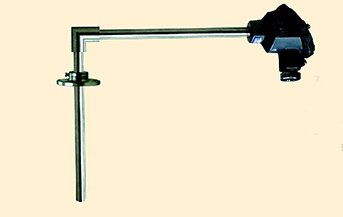
Overview:
The right-angle thermocouple is a specially designed temperature sensing device with a 90-degree bent probe structure. It is ideal for installation in restricted or angled spaces where standard straight thermocouples cannot be applied. This design improves accessibility and simplifies routing in complex industrial environments.
Working Principle:
The thermocouple operates based on the Seebeck effect—when two dissimilar metal wires are joined at one end (the sensing junction), a voltage is generated that correlates to the temperature at the measuring point. This voltage is interpreted by a temperature controller or data acquisition system.
Applications:
- Power plants and boiler systems
- Chemical processing pipelines
- Mechanical equipment with space constraints
- HVAC systems
- Food and pharmaceutical machinery
- Petrochemical facilities
Structure & Materials:
| Component | Description |
|---|---|
| Sensing Element | Thermocouple wire (Type K, J, T, E, N, etc.) |
| Sheath Material | SS304, SS316, Inconel 600, or ceramic—based on environment requirements |
| Probe Diameter | Typically from Ø3mm to Ø8mm (custom sizes available) |
| Bend Angle | Standard 90° right-angle; custom angles available |
| Insulation | High-temperature ceramic, mineral insulation (for armored type) |
| Mounting Options | Fixed thread, adjustable compression fitting, flange, or bayonet cap |
| Connection Head | Weatherproof terminal head, miniature plug, or direct cable lead |
| Temperature Range | -50°C to +1100°C (varies by thermocouple type and sheath material) |
| Accuracy Class | Class I or II according to IEC 60584 |
Features:
- Right-angle bend enables easy installation in limited space
- High mechanical strength and vibration resistance
- Customizable insertion length and process fittings
- Fast response time due to compact sensing tip
- Compatible with most industrial control systems
